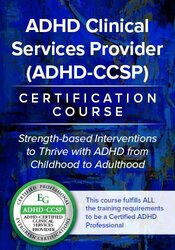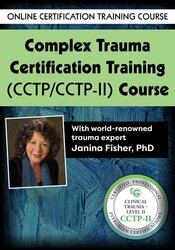Description
Clients who are experiencing panic want relief from their suffering. And given that it took a mountain of courage just to show up at your door, you want to help them as quickly and effectively as you can. But without proper training, panic attacks can be very confusing and difficult to treat. It is very common that well-intentioned therapists inadvertently reinforce avoidance or escape behaviours, thereby prolonging recovery, worsening symptoms—leading to client drop out.
Watch anxiety expert and author, Elena Welsh, Ph.D., as she shares her treatment secrets that consistently improve the lives of her clients suffering from panic and anxiety. Using the best techniques from Acceptance and Commitment Therapy (ACT), mindfulness, and Cognitive Behavioral Therapy (CBT), Dr. Welsh lays out practical, step-by-step integrated treatment strategies that you can use right away, including how to:
- Differentiate diagnostically between panic disorder and panic attacks
- Provide psychoeducation that is non-pathologizing and immediately useful for clients
- Empower clients to increase their comfort level and accept difficult/distressing thoughts, feelings, and sensations
- Teach clients to preemptively catch and reframe thoughts that fuel anxiety and panic
- Motivate clients to shift behaviours to reduce the severity and frequency of panic/fear reactions
- Guide clients through exposure protocols to manage panic/fear reactions
- Manage your own anxiety about treating panicked and anxious clients
Do not let another client walk out that door wondering if they could live without panic and anxiety.
Purchase today!
CPD
CPD
This online program is worth 6.5 hours CPD.
Speaker
The Access Tree
Elena Welsh, Ph.D., is a licensed clinical psychologist who specializes in working with clients with anxiety disorders from all walks of life in both inpatient and outpatient treatment settings. She also works with a wide range of mood and depressive disorders, including bipolar disorder, major depression, and post-traumatic stress disorder/trauma-related mental health issues.
Dr. Welsh has published articles in various medical and research journals and is the author of The Cognitive Therapy Workbook for Panic Attacks; Trauma Survivors' Strategies for Healing: A Workbook to Help You Grow, Rebuild, and Take Back Your Life; Getting to Good: A Guided Journal; and 5-Minute Stress Relief: 75 Exercises to Quiet Your Mind and Calm Your Body. She has served as an adjunct faculty member at various universities in Los Angeles.
Dr. Welsh received her doctorate degree from the University of Maryland, Baltimore County and completed advanced clinical training through a postdoctoral fellowship at Gateways Psychiatric Hospital in Los Angeles.
Speaker Disclosures:
Financial: Elena Welsh maintains a private practice and has an employment relationship with California Department of State Hospitals. She receives royalties as a published author. Elena Welsh receives a speaking honorarium, recording royalties, and book royalties from PESI, Inc. She has no relevant financial relationships with ineligible organizations.
Non-financial: Elena Welsh has no relevant non-financial relationships.
Objectives
- Differentiate diagnostically between panic disorder and panic attacks that are secondary to other anxiety disorders.
- Utilize psychoeducation as an intervention to teach clients about the physiology of fear and avoidance as well as the physical sensations that typically comprise a panic attack.
- Employ tools to assess problematic thought patterns that fuel anxiety and panic.
- Implement mindfulness and acceptance, and cognitive strategies to target distorted thinking.
- Develop and execute graduated, imaginal and/or in vivo exposure strategies to directly reduce the frequency and intensity of panic attacks.
- Design tools to track treatment progress and help clients stay on track.
Outline
Assessment: Accurately Diagnose Panic and Anxiety Disorders
- Panic disorder vs. panic attacks that are secondary to other anxiety disorders
- Psychosocial factors that may exacerbate panic symptoms
- Impact on client’s social and occupational functioning
- Is the client’s support system inadvertently reinforcing panic symptoms?
INTEGRATING ACT, CBT, & MINDFULNESS INTO YOUR THERAPEUTIC TOOLBOX
Psychoeducation: The Essential Foundation of Anxiety Treatment
- Teach clients about the physiology of fearand avoidance in a non-pathologizing manner
- When the body is behaving normally, just at the wrong time!
- Physical sensations that comprise a panic attack
- How short-term relief (avoidance, distraction, etc) isn’t enough to yield long-term wellness
- Teach clients ‘the why’ of exposure before going through it
Cognitive Behaviour Therapy (CBT): Target Cognitive Distortions that are Common in Anxiety
- Catastrophizing, jumping to conclusions, tunnel vision, emotional reasoning, and overgeneralization
- Tools to help clients gain awareness of and reframe distorted thinking
- Disrupt the link between thoughts and unhelpful/avoidance/escape behaviours
- Help clients critically examine the beliefs they hold about panic and its aftermath
Exposure Techniques: Breaking the Anxiety and Panic Cycle
- The importance of client buy-in for exposure to be effective
- How to develop graduated exposure plan
- Subjective Units of Distress (SUDs) ratings to improve clinician-client communication
- In-vivo vs. imaginal exposure
- The importance of remaining in an exposure exercise until fear subsides
- Modify exposure for telehealth
Acceptance and Commitment Therapy (ACT): Teaching Clients to “Drop the Rope”
- Values clarification
- Use of metaphors
- Exercises to increase comfort with difficult emotions and sensations
Tools for Calming the Body in the Midst of Panic
- Breathing skills to interrupt worry thoughts and slow down physiological panic symptoms
- Relaxation techniques to reduce vulnerability to panic
- Grounding techniques to lower the intensity
- How a daily mindfulness practice can reduce panic
Recovery Maintenance Tools: Make Sure Therapy is Working and Help Clients Stay on Track
- Individualized methods of tracking success and challenges
- Help clients maintain consistent skills practice and reduce avoidance behaviours
- Maintain a panic attack progress tracking tool
- Connect treatment to client’s goals and values
Other Clinical Considerations
- Anxiety and panic during challenging times
- Increased anxiety rates during public health crisis
- Complicating factors of hypochondriasis and panic disorder
- Limitations of the research and potential risks
Target Audience
- Social Workers
- Psychologists
- Counselors
- Case Managers
- Addiction Counselors
- Therapists
- Nurses
- Marriage & Family Therapists
- Psychiatrists
- Other Mental Health Professionals
Reviews
Overall:
5
Total Reviews: 1
















